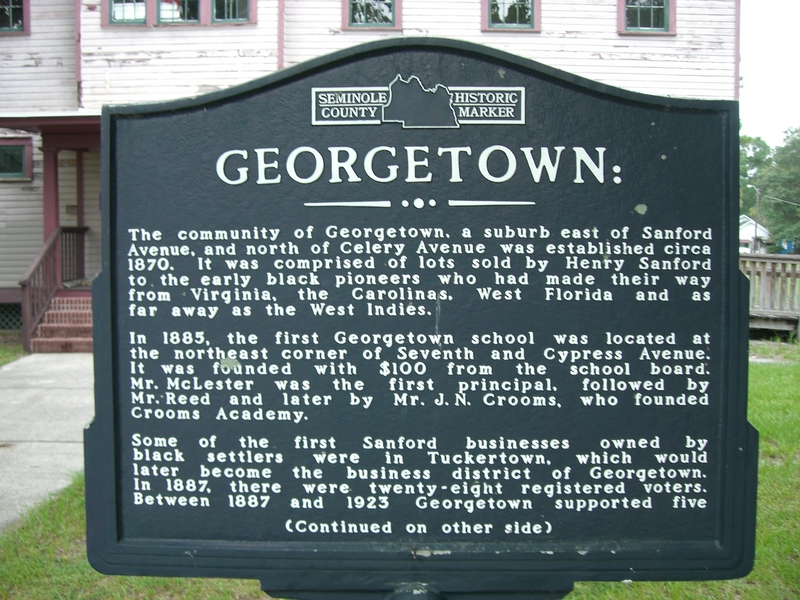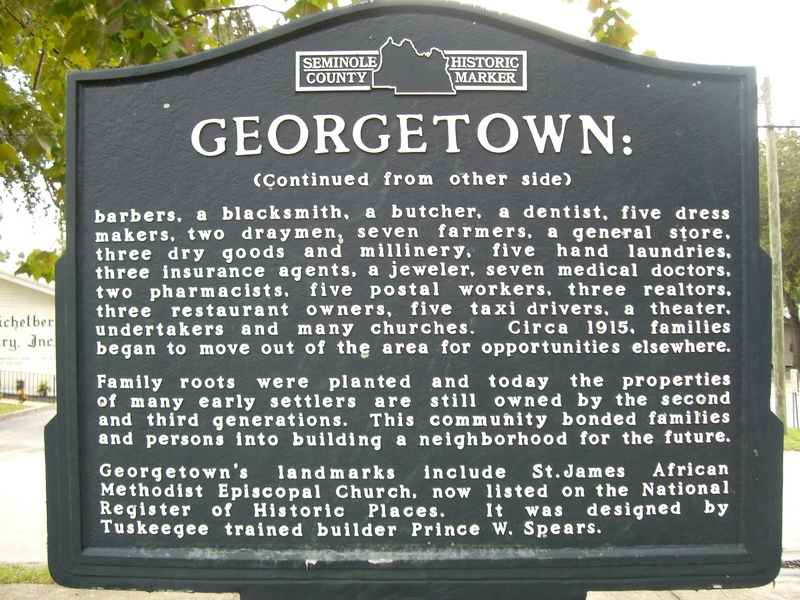Georgetown Historic Marker
Dublin Core
Title
Georgetown Historic Marker
Alternative Title
Georgetown Historic Marker
Subject
African Americans--Florida
Georgetown (Sanford, Fla.)
Historical markers--Florida
Sanford (Fla.)
Segregation
Description
Seminole County Historic Marker about the community of Georgetown in Sanford, Florida. Henry Shelton Sanford established Georgetown in the 1870s as a community for migrating African Americans to settle. Georgetown became a self-sustaining community with its own commercial district and schools operated by African Americans. Georgetown remained a safe haven for the African-American population in Sanford during times of racial violence during the twentieth century.
Creator
Rock, Adam
Source
Original digital color images by Adam Rock, July 30, 2011.
Publisher
Date Created
2011-07-30
Contributor
Rock, Adam
Is Part Of
Georgetown Collection, Sanford Collection, Seminole County Collection, RICHES of Central Florida.
Format
image/jpeg
Extent
3.68 MB
Medium
2 digital color images
Language
eng
Type
Still Image
Coverage
Sanford, Florida
Spatial Coverage
28.802215, -81.262294
Temporal Coverage
1870-01-01/2011-07-30
Accrual Method
Item Creation
Mediator
History Teacher
Economics Teacher
Geography Teacher
Provenance
Originally created by Adam Rock.
Rights Holder
Contributing Project
Curator
Rock, Adam
Digital Collection
Source Repository
External Reference
Bentley, Altermese. Georgetown, The History of A Black Neighborhood. Sanford: Reprinted by the Sanford Museum, 1995.
Bently, Altermese Smith. Seminole County. Charleston, South Carolina: Arcadia, 2000.
Flewellyn, Valada. African Americans of Sanford. Charleston, South Carolina: Arcadia, 2009. ISBN 0738567620.
Orange County Black Communities Survey: Phase 1- Seminole County Project Report. Orlando: Yealding & Provost, 1990.
"Touring Seminole County." Historical Markers Program, Seminole County Historical Commission. http://www.seminolecountyfl.gov/departments-services/leisure-services/parks-recreation/museum-of-seminole-county-history/about-the-museum-of-seminole-county-hi/museum-resources-historical-informatio/historical-markers.stml.
External Reference Title
Transcript
SEMINOLE COUNTY HISTORIC MARKER
GEORGETOWN:
The community of Georgetown, a suburb east of Sanford Avenue, and north of Celery Avenue was established circa to the early black pioneers who had made their way from Virginia, the Carolinas, West Florida and as far away as the West Indies.
In 1885, the first Georgetown school was located at the northeast corner of Seventh and Cypress Avenue. It was founded with $100 from the school board. Mr. McLester was the first principal, followed by Mr. Reed and later by Mr. J. N. Crooms, who founded Crooms Academy.
Some of the first Sanford businesses owned by black settlers were in Tuckertown, which would later become the business district of Georgetown. In 1887, there were twenty-eight registered voters. Between 1887 and 1923 Georgetown supported five ( Continued on other side)
GEORGETOWN:
The community of Georgetown, a suburb east of Sanford Avenue, and north of Celery Avenue was established circa to the early black pioneers who had made their way from Virginia, the Carolinas, West Florida and as far away as the West Indies.
In 1885, the first Georgetown school was located at the northeast corner of Seventh and Cypress Avenue. It was founded with $100 from the school board. Mr. McLester was the first principal, followed by Mr. Reed and later by Mr. J. N. Crooms, who founded Crooms Academy.
Some of the first Sanford businesses owned by black settlers were in Tuckertown, which would later become the business district of Georgetown. In 1887, there were twenty-eight registered voters. Between 1887 and 1923 Georgetown supported five ( Continued on other side)
GEORGETOWN:
(continued from other side)
barbers, a blacksmith, a butcher, a dentist, five dress makers, two draymen, seven farmers, a general store, three dry goods and millinery,five hand laundries, two pharmacists, five postal workers, three realtor, three restaurant owners, five taxi drivers, a theater, undertakers and many churches. Circa 1915, families began to move out of the area for opportunities elsewhere.
Family roots were planted and today the properties of many early settlers are still owned by the second and third generations. This community bonded families and persons into building a neighborhood for the future.
Georgetown's landmarks include St. James African Methodist Episcopal Church, now listed on the National Register of Historic Places. It was designed by Tuskeegee trained builder Prince W. Spears.
(continued from other side)
barbers, a blacksmith, a butcher, a dentist, five dress makers, two draymen, seven farmers, a general store, three dry goods and millinery,five hand laundries, two pharmacists, five postal workers, three realtor, three restaurant owners, five taxi drivers, a theater, undertakers and many churches. Circa 1915, families began to move out of the area for opportunities elsewhere.
Family roots were planted and today the properties of many early settlers are still owned by the second and third generations. This community bonded families and persons into building a neighborhood for the future.
Georgetown's landmarks include St. James African Methodist Episcopal Church, now listed on the National Register of Historic Places. It was designed by Tuskeegee trained builder Prince W. Spears.
Still Image Item Type Metadata
Original Format
2 color digital images
Collection
Citation
Rock, Adam, “Georgetown Historic Marker,” RICHES, accessed January 11, 2026, https://richesmi.cah.ucf.edu/omeka/items/show/1032.

